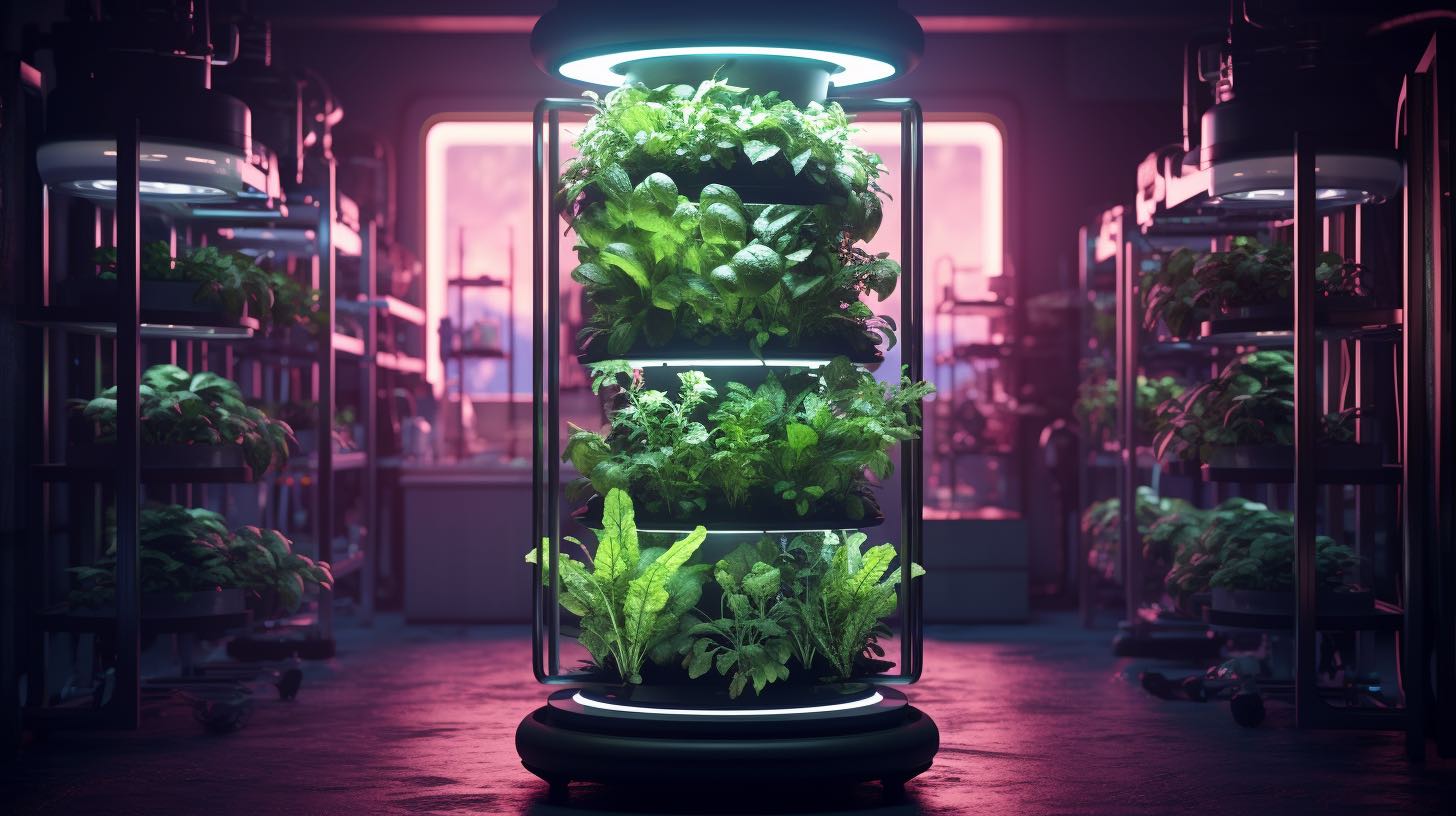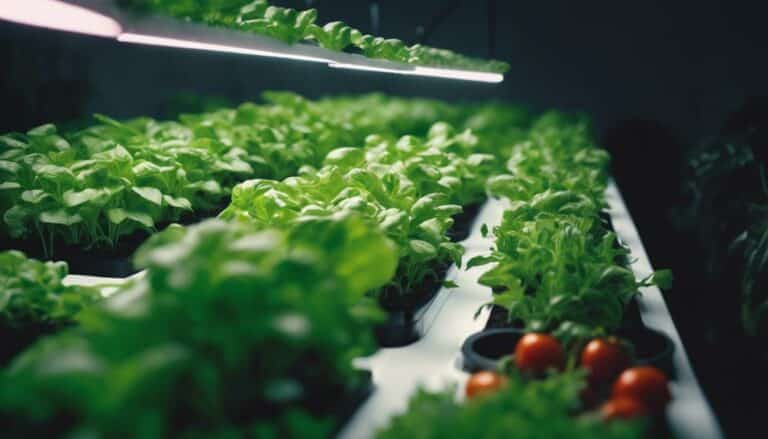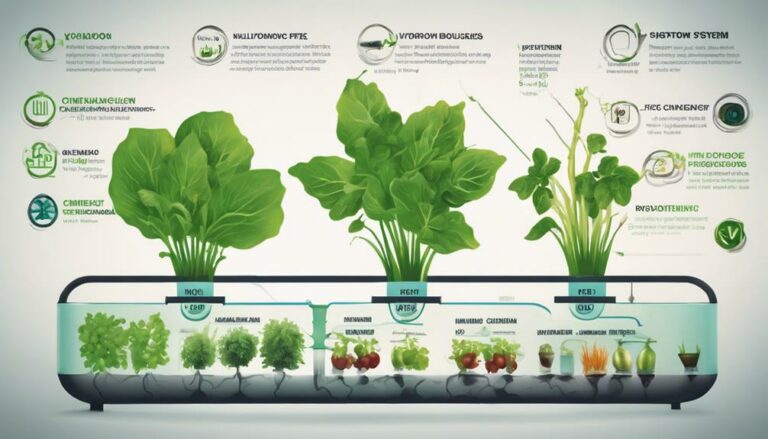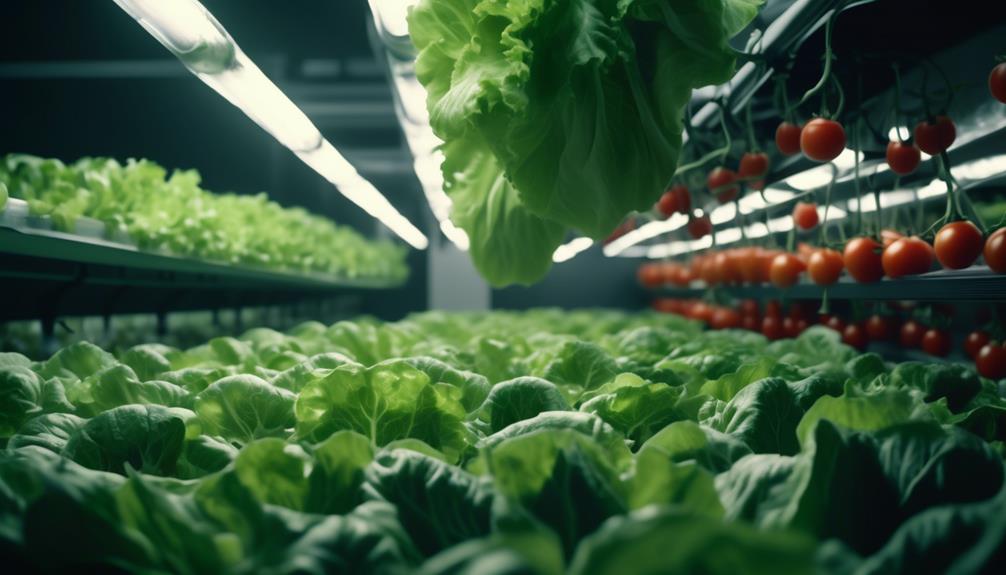I’ve researched and compiled a list of the best hydroponic systems for growing leafy greens. These systems, such as Nutrient Film Technique (NFT), Deep Water Culture (DWC), Aeroponic, Drip Irrigation, Wick, Ebb and Flow, and Vertical Hydroponic systems, offer innovative and efficient ways to maximize your yields.
With their advanced features and precise nutrient delivery, you can expect healthier and more vibrant greens.
Table of Contents
Whether you’re a beginner or an experienced grower, these systems will revolutionize your leafy green cultivation.
Key Takeaways
- Nutrient Film Technique (NFT) systems and Deep Water Culture (DWC) systems are efficient options for growing leafy greens with reduced water consumption and high yields.
- Drip irrigation systems deliver water and nutrients directly to the roots, minimizing waste and maximizing efficiency.
- Wick systems are a low-cost and low-maintenance option for beginners or those on a budget, but may lead to uneven growth and may not meet the nutrient demands of certain plants.
- Ebb and Flow systems, also known as flood and drain systems, promote healthy growth and nutrient absorption, but require proper maintenance to prevent system failure.
Nutrient Film Technique (NFT) Systems
I find the Nutrient Film Technique (NFT) systems to be an efficient way of growing leafy greens. NFT systems work by continuously flowing a thin film of nutrient-rich water over the roots of the plants, allowing them to absorb the necessary nutrients.
One of the main advantages of NFT systems is their water efficiency. Since the water is recirculated, it reduces the overall water consumption compared to traditional soil-based farming. Additionally, NFT systems have a smaller footprint, making them ideal for urban environments with limited space.
However, there are a few cons to consider. NFT systems require regular monitoring and maintenance to ensure that the water flow is properly balanced and that the roots don’t become clogged. It’s essential to regularly check the pH levels and nutrient concentrations to maintain optimal growing conditions.
With proper maintenance, NFT systems can provide a consistent and high-yielding harvest of leafy greens.
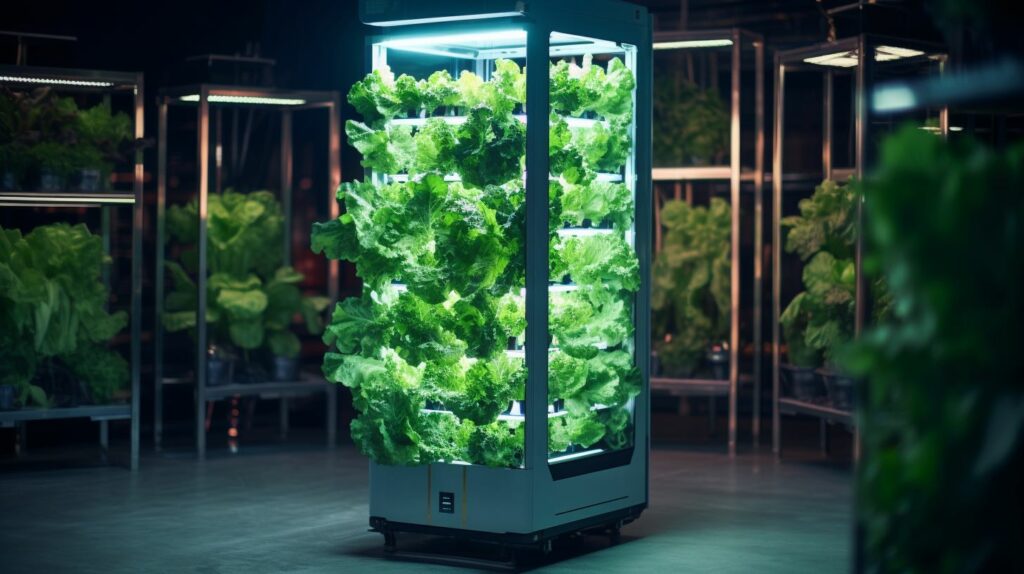
Deep Water Culture (DWC) Systems
I’ve had some experience with Deep Water Culture (DWC) systems, and I must say, they’re quite fascinating.
In DWC systems, plants are suspended in a nutrient-rich water solution, with their roots submerged in the water. This allows for optimal nutrient uptake and oxygenation of the roots, leading to impressive plant growth.
DWC Benefits and Drawbacks
One benefit of DWC hydroponic systems is the ability to easily monitor and adjust nutrient levels. This is essential for optimizing the growth of leafy greens. With DWC, the plants are suspended in a nutrient-rich solution, allowing the roots to uptake the necessary nutrients directly.
The continuous flow of oxygenated water ensures that the plants receive ample oxygen for healthy growth. Additionally, DWC systems are relatively simple to set up and maintain, making them accessible to beginners in hydroponics.
However, there are some drawbacks to consider. Since the plants are constantly submerged in water, there’s a risk of root rot if the oxygenation system fails. It’s important to regularly check the oxygen levels and pH levels to prevent any nutrient imbalances.
Proper maintenance and regular monitoring are key to optimizing a DWC system.
Optimal Plant Growth
To maximize the growth of my plants, I need to ensure they have the right balance of nutrients, proper lighting, and consistent monitoring of temperature and humidity levels. Plant nutrition is crucial for healthy growth and development. By providing the necessary nutrients, plants can thrive and reach their full potential. Water quality is also important in hydroponic systems as it directly affects plant health. Impurities or imbalances in water can hinder nutrient uptake and lead to nutrient deficiencies or toxicities. In order to ensure optimal plant growth, it is essential to monitor and maintain the water quality by regularly testing pH levels and checking for any contaminants. This will help create a stable and controlled environment for the plants to grow and flourish.
| Nutrients | Lighting | Temperature and Humidity |
|---|---|---|
| Nitrogen | LED grow lights | Optimal temperature: 65-75°F |
| Phosphorus | Natural sunlight | Ideal humidity: 50-70% |
| Potassium | Fluorescent grow lights | Consistent temperature and humidity |
Aeroponic Systems
I’m considering using aeroponic systems for my hydroponic setup to grow leafy greens.
Aeroponic systems offer several benefits that make them an innovative choice for hydroponic farming.
One major advantage is the efficient use of water. Unlike traditional farming methods, aeroponic systems require less water as they mist the plant roots with a nutrient-rich solution. This leads to water savings of up to 95% compared to conventional farming.
Additionally, aeroponic systems promote faster growth and higher crop yields. The plants receive a continuous supply of oxygen, nutrients, and water, which enhances their overall health and productivity.
However, there are challenges with aeroponic farming, such as maintaining a stable environment with precise control over temperature, humidity, and pH levels. These factors require careful monitoring and adjustment to ensure optimal plant growth.
Despite these challenges, the benefits of aeroponic systems make them an attractive option for those seeking innovative hydroponic solutions.
Drip Irrigation Systems
I find drip irrigation systems to be an effective method for delivering water and nutrients directly to the plant roots in vertical farming of hydroponic lettuce.
This innovative system utilizes a network of tubes and emitters to deliver a precise amount of water to each plant, minimizing waste and maximizing efficiency. The water is distributed in a slow, steady drip, ensuring that the plant’s roots are constantly hydrated without the risk of overwatering.
This targeted approach allows for better nutrient absorption and reduces the risk of diseases caused by excess moisture. Drip irrigation systems also help to conserve water, making them a sustainable choice for vertical farming operations.
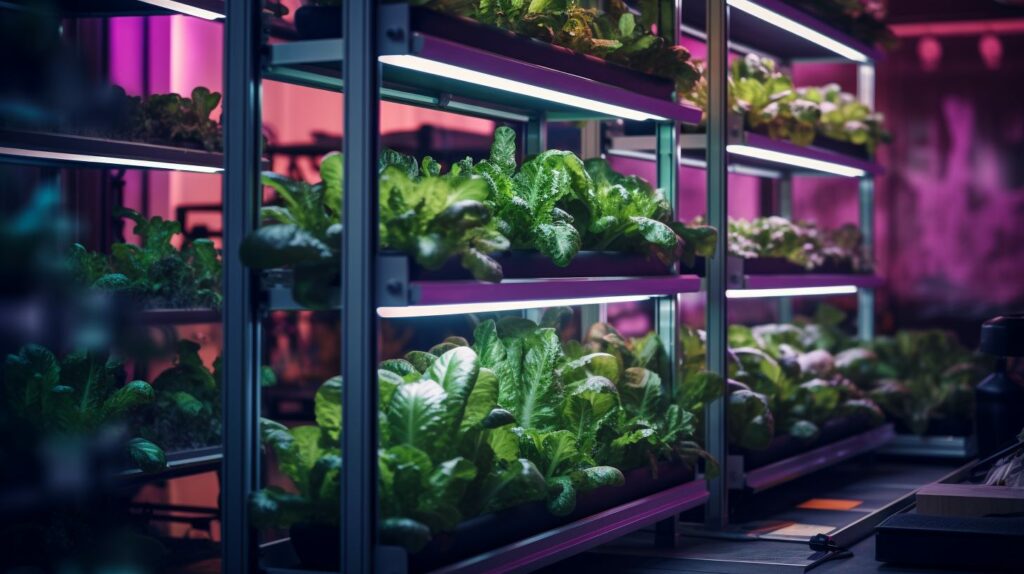
Wick Systems
Now, let’s dive into the world of Wick Systems. As a hydroponic enthusiast, I’ve always been intrigued by the simplicity and effectiveness of this method.
Wick systems are a passive form of hydroponics, where the nutrient solution is drawn up into the growing medium through a wick.
One of the main advantages of wick systems is their low cost and ease of setup. They require minimal equipment and are perfect for beginners or those on a budget. Another benefit is their low maintenance nature, as there are no pumps or timers to worry about.
However, wick systems do have their limitations. The rate at which the nutrient solution is delivered to the plants can be inconsistent, which may lead to uneven growth. Additionally, some plants with higher nutrient demands may not thrive in a wick system.
When it comes to wick materials, there are several options to choose from. Common choices include cotton, nylon, and polyester. Each material has its own set of pros and cons, such as absorption rate, durability, and resistance to clogging. It’s important to consider the specific needs of your plants when selecting the wick material for your system.
Ebb and Flow Systems
Ebb and flow systems, also known as flood and drain systems, are a popular choice in hydroponics. In this system, nutrient-rich water is periodically pumped into the growing tray and then drained back into the reservoir.
This cyclic process ensures that the plants receive both water and nutrients, promoting healthy growth and reducing the risk of overwatering.
Benefits of Ebb & Flow
The benefits of using an Ebb & Flow hydroponic system include increased nutrient absorption and improved oxygenation for healthier and faster-growing leafy greens. Ebb & Flow systems, also known as flood and drain systems, are popular among hydroponic enthusiasts for their efficiency and simplicity.
The pros of using an Ebb & Flow system are numerous. Firstly, it allows for precise nutrient delivery, ensuring that plants receive the right amount of nutrients at the right time. Additionally, the periodic flooding and draining of the system provides ample oxygenation to the roots, promoting robust growth.
However, there are a few cons to consider. The main drawback is the potential for system failure due to pump malfunctions or power outages.
To set up an Ebb & Flow system efficiently, start by selecting a suitable container and tray. Then, install a submersible pump and connect it to a timer. Finally, add a growing medium and plant your leafy greens.
With proper maintenance, an Ebb & Flow system can be a game-changer for your hydroponic garden, offering exceptional results and optimal growing conditions for your leafy greens.
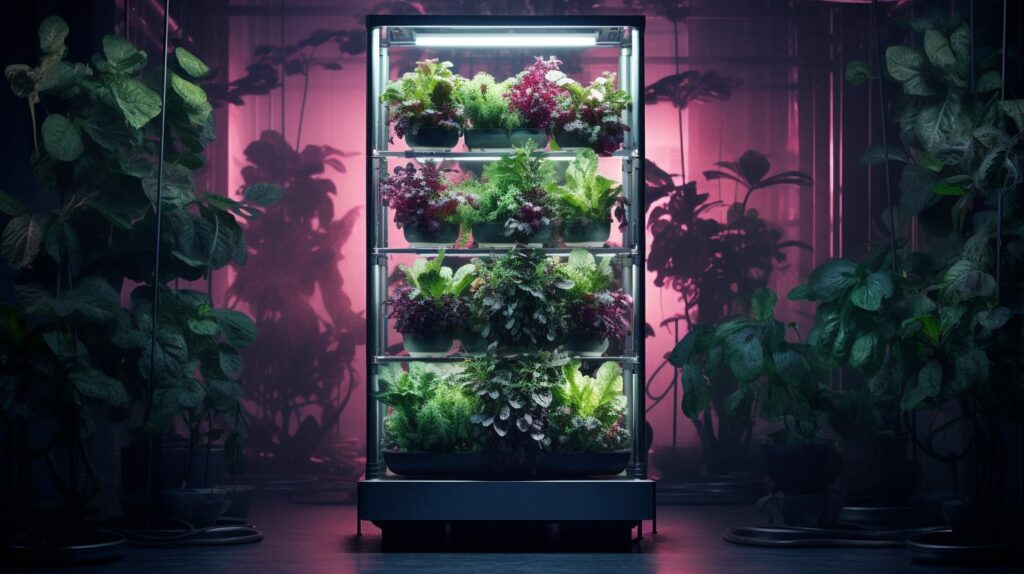
Tips for Optimal Results
Now that we have discussed the benefits of the Ebb & Flow hydroponic system, let’s explore some tips for achieving optimal results in your leafy greens growth. Two crucial factors to consider are hydroponic nutrient solutions and lighting for hydroponic systems.
Hydroponic nutrient solutions play a vital role in providing the necessary nutrients for plant growth. It is essential to choose a well-balanced solution that meets the specific needs of leafy greens. Regular monitoring of pH levels and adjusting as needed will ensure optimal nutrient absorption.
When it comes to lighting, using the right spectrum and intensity is key. LED grow lights are highly recommended for hydroponic systems. They are energy-efficient, long-lasting, and provide a full spectrum of light. Position the lights at an appropriate distance from the plants to ensure even coverage and prevent light burn.
By carefully selecting hydroponic nutrient solutions and using suitable lighting, you can maximize the growth and yield of your leafy greens in a hydroponic system. Let’s take a look at the table below for a quick overview:
| Tips for Optimal Results |
|---|
| Choose balanced hydroponic nutrient solutions |
| Monitor and adjust pH levels |
| Use LED grow lights for proper lighting |
Vertical Hydroponic Systems
I’ve found that vertical hydroponic systems are a great option for growing leafy greens in limited spaces. These innovative designs maximize space utilization while maintaining optimal growing conditions.
Vertical hydroponic systems utilize vertical stacking of planters, allowing for more plants to be grown in a smaller footprint. The design typically includes multiple tiers or levels, each equipped with its own nutrient delivery system. This ensures that each plant receives the necessary water and nutrients for optimal growth.
Moreover, the vertical arrangement allows for efficient use of lighting, as the plants are evenly distributed and exposed to adequate light.
These space-saving hydroponic systems are ideal for urban environments or small gardens, where space is limited but the desire for fresh, homegrown produce is high. With vertical hydroponic systems, anyone can enjoy a bountiful harvest of leafy greens, regardless of their available space.
How Do Ph and EC Levels Affect the Growth of Leafy Greens in Hydroponics?
The ideal hydroponics ph and ec levels guide is vital for the successful growth of leafy greens. pH levels impact nutrient absorption, with a range of 5.5-6.5 being optimal. EC levels indicate the concentration of nutrients in the water, ensuring a balanced nutrient supply. Maintaining appropriate levels promotes healthy plant growth and maximizes yields in hydroponic systems.
Frequently Asked Questions
What Are the Benefits of Using a Specific Hydroponic System for Growing Leafy Greens?
Using a specific hydroponic system for growing leafy greens offers numerous benefits. It allows for precise control of nutrient intake, leading to healthier and more productive plants. By optimizing nutrient levels, leafy greens can reach their full potential in hydroponic systems.
How Much Maintenance Is Required for Each Type of Hydroponic System?
Maintaining hydroponic systems varies depending on the type. Different systems have pros and cons in terms of maintenance. Comparing the cost effectiveness of maintenance is crucial for choosing the best hydroponic system for growing leafy greens.
Can These Hydroponic Systems Be Used for Growing Other Types of Plants Besides Leafy Greens?
Yes, these hydroponic systems can be used for growing a variety of plants besides leafy greens. The advantages of hydroponic farming include the ability to grow alternative crops and optimize conditions for different plant varieties.
Are These Systems Suitable for Both Indoor and Outdoor Cultivation?
Yes, hydroponic systems can be used for both indoor and outdoor cultivation. However, there are pros and cons for each. Indoor cultivation allows for year-round growing, while outdoor cultivation benefits from natural sunlight.
What Is the Average Yield of Leafy Greens When Using Each Type of Hydroponic System?
When comparing the average yield of leafy greens in different hydroponic systems, it’s important to consider the nutrient requirements. Each system has its own advantages and disadvantages, which can affect yield.
Conclusion
In conclusion, when it comes to growing leafy greens hydroponically, there are several excellent options to choose from.
The Nutrient Film Technique (NFT) and Deep Water Culture (DWC) systems provide efficient and effective methods of nutrient delivery.
Aeroponic systems offer precise misting of nutrient solutions, while drip irrigation systems provide consistent and controlled water supply.
Wick systems are a simple and low-maintenance choice, while Ebb and Flow systems allow for periodic flooding and draining.
Lastly, vertical hydroponic systems maximize space utilization.
Choose the system that best suits your needs and enjoy bountiful harvests of delicious leafy greens.

